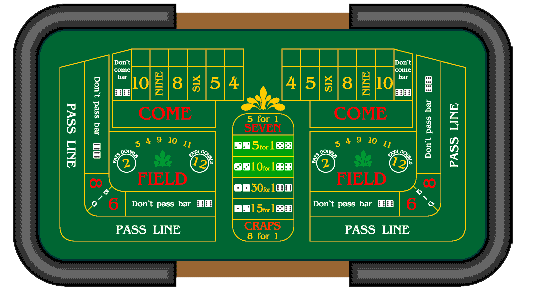How to play Craps
Craps is a casino game with a history that spans hundreds of years. In fact, some historians claim that an early form can be dated all the way back to the Crusades. It was evolved by French gamblers, then introduced to New Orleans gambling houses in the 19th century, then became a popular game during World War II, all before it entered the lobby of every brick-and-mortar casino in the world. It’s fun to think we’re playing a game with that kind of staying power, and thanks to modern technology, the same odds, winning potential, excitement, and entertainment is always just a few clicks away.
The Setup
What was once a street corner with a curb as the wall is now a specially designed table specifically used for Craps. It looks like a high bathtub, with an oval counter that surrounds the betting area (or tub), and a specially padded wall to ensure the throw of the dice is truly random. The online version is great for new players, because a real-life Craps table surrounded by players that know what they’re doing can be an intimidating environment. Players place chips directly on the betting area, and when the game begins, dice are thrown, and the game can end right there or move forward depending on how the dice land.
How to Play
In a land-based casino, there is a designated thrower, but in the online version, players are simply betting on the result of the game. While the rules might seem complex at first, learning them can be very rewarding, because the in-depth excitement holds more value in the long run than a simple setup of click-and-hope.

The most common bets and the two with the lowest house edge are the “Pass Line” and the “Don’t Pass Bar,” both with a 1 to 1, double or nothing payout. You will notice that there is a button flipped to the black “Off” side, representing the Come-Out phase. When that initial bet is placed, the dice will be thrown, which is known as the come-out roll. The result of the throw is based on the numbers on the two dice being added together. If that number is 2, 3, or 12, the “Pass Line” bet loses, and the “Don’t Pass Bar” bet wins. This is called “crapping out.” If that number is a 7 or 11, the “Pass Line” wins, and the “Don’t Pass Bar” does not. If any other number is thrown, the button is switched to the white “On” side and shifted to that number at the top of the table, which is called the Point phase. The number thrown sets the Point number, and both bets remain.
During the Point phase, players have the opportunity to place additional bets. You can bet that one of the dice rolls will be a specific pair of dice, a certain total, or that the Point number will be thrown before a seven. If a seven is thrown before the point number, the game ends and the Pass Line bet is lost, while the Don’t Pass Bar bet is won. The Pass Line bet is won if the Point number is thrown before a seven. Underneath or in the help menu of every online Craps that you will find online, they will show you the exact payout of each bet, a helpful addition that furthers the advantage of playing Craps online instead of at a real-life casino. Best of all, once you’re comfortable playing the online version, you are ready to play at the real life version if the opportunity presents itself. The main difference between the two is the addition of a thrower, who has to place a bet on the Pass or Don’t Pass spaces, throwing the dice that other players can bet on until they crap out.
Conclusion
Craps is an iconic staple of the casino both land-based and online. It has a thrilling amount of suspense, enough depth to keep it interesting for the long haul, and has the winning potential likelihood perfect for conservative betters, progressive betters, and high rollers alike. When you can win a payout of 1 to 1 all the way up to 30 to 1 or better, have the opportunity to place more bets as the game progresses, and other distinct features, it’s no wonder it’s one of the most popular betting options around.
Casino menu 




 Blackjack
Blackjack
 Roulette
Roulette
 Slots
Slots
 Baccarat
Baccarat



